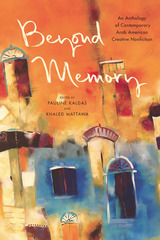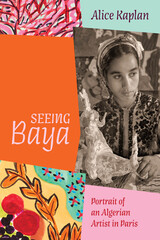3 books about Arab & Middle Eastern

Autumn Equinox
Jabbour Douaihy
University of Arkansas Press, 2001
Jabbour Douaihy’s Autumn Equinox is a diary of a young man recently resettled in his Lebanese village after going to college in the United States. It continues from the end of May through the September equinox of 1986, narrating his efforts to remake himself through adjustments to his reading, writing, and eating habits, his dress, his posture, his family relationships, his love life. . . .
The diary begins with a view of an Israeli bombing in South Lebanon and ends with a description of refugee families fleeing to the mountain villages. Otherwise, except for allusions to what is going on in the capital, the Lebanese Civil War is far from the story, although its violence has never been far from this village. America, personified by a Lara who does not answer his letters, is a faraway land of nostalgia. The village is here, at the center of the young man’s narration, peopled by comic characters who seem to insist on their own unchanging selfhoods and to resist his attempts to be different.
The Civil War and the Occupation, the author seems to be saying, are not the only sources of turmoil. Violence and revenge have been part of the people’s consciousness, and people might indeed need to redefine themselves while at the same time adjusting to the environment.
The diary begins with a view of an Israeli bombing in South Lebanon and ends with a description of refugee families fleeing to the mountain villages. Otherwise, except for allusions to what is going on in the capital, the Lebanese Civil War is far from the story, although its violence has never been far from this village. America, personified by a Lara who does not answer his letters, is a faraway land of nostalgia. The village is here, at the center of the young man’s narration, peopled by comic characters who seem to insist on their own unchanging selfhoods and to resist his attempts to be different.
The Civil War and the Occupation, the author seems to be saying, are not the only sources of turmoil. Violence and revenge have been part of the people’s consciousness, and people might indeed need to redefine themselves while at the same time adjusting to the environment.
[more]

Beyond Memory
An Anthology of Contemporary Arab American Creative Nonfiction
Pauline Kaldas
University of Arkansas Press, 2020
This anthology brings together the voices of both new and established Arab American writers in a compilation of creative nonfiction that reveals the stories of the Arab diaspora in styles that range from the traditional to the experimental. Writers from Egypt, Lebanon, Libya, Palestine, and Syria explore issues related to politics, family, culture, and racism. Coming from different belief systems and cultures and including first- and second-generation immigrants as well as those whose identities encompass more than a single culture, these writers tell stories that speak to the complexity of the Arab American experience.
[more]

Seeing Baya
Portrait of an Algerian Artist in Paris
Alice Kaplan
University of Chicago Press, 2024
The first biography of the Algerian artist Baya Mahieddine, celebrated in mid-twentieth-century Paris, her life shrouded in myth.
On a flower farm in colonial Algeria, a servant and field worker named Baya escaped the drudgery of her labor by coloring the skirts in fashion magazines. Three years later, in November 1947, her paintings and fanciful clay beasts were featured in a one-woman show at the Maeght Gallery in Paris. She wasn’t yet sixteen years old. Alice Kaplan tells the story of a young woman seemingly trapped in subsistence who becomes a sensation in the French capital, then mysteriously fades from the history of modern art—only to reemerge after independence as an icon of Algerian artistic heritage.
The toast of Paris for the 1947 season, Baya inspired colonialist fantasies about her “primitive" genius as well as genuine appreciation. She was featured in newspapers, radio, and a newsreel; her art was praised by Breton and Camus, Matisse and Braque. At the dawn of Algerian liberation, her appearance in Paris was used to stage the illusion of French-Algerian friendship, while horrific French massacres in Algeria were still fresh in memory.
Kaplan uncovers the central figures in Baya’s life and the role they played in her artistic career. Among the most poignant was Marguerite Caminat-McEwen-Benhoura, who took Baya from her sister’s farm to Algiers to work as her maid and gave the young girl paint and brushes. A complex and endearing character, Marguerite’s Pygmalion ambitions were decisive in determining Baya’s destiny. Kaplan also looks closely at Baya’s earliest paintings with an eye to their themes, their palette and design, and their enduring influence.
In vivid prose that brings Baya’s story into the present, Kaplan’s book, the fruit of scrupulous research in Algiers, Blida, Paris, and Provence, allows us to see in a whole new light the beloved artist who signed her paintings simply “Baya.”
On a flower farm in colonial Algeria, a servant and field worker named Baya escaped the drudgery of her labor by coloring the skirts in fashion magazines. Three years later, in November 1947, her paintings and fanciful clay beasts were featured in a one-woman show at the Maeght Gallery in Paris. She wasn’t yet sixteen years old. Alice Kaplan tells the story of a young woman seemingly trapped in subsistence who becomes a sensation in the French capital, then mysteriously fades from the history of modern art—only to reemerge after independence as an icon of Algerian artistic heritage.
The toast of Paris for the 1947 season, Baya inspired colonialist fantasies about her “primitive" genius as well as genuine appreciation. She was featured in newspapers, radio, and a newsreel; her art was praised by Breton and Camus, Matisse and Braque. At the dawn of Algerian liberation, her appearance in Paris was used to stage the illusion of French-Algerian friendship, while horrific French massacres in Algeria were still fresh in memory.
Kaplan uncovers the central figures in Baya’s life and the role they played in her artistic career. Among the most poignant was Marguerite Caminat-McEwen-Benhoura, who took Baya from her sister’s farm to Algiers to work as her maid and gave the young girl paint and brushes. A complex and endearing character, Marguerite’s Pygmalion ambitions were decisive in determining Baya’s destiny. Kaplan also looks closely at Baya’s earliest paintings with an eye to their themes, their palette and design, and their enduring influence.
In vivid prose that brings Baya’s story into the present, Kaplan’s book, the fruit of scrupulous research in Algiers, Blida, Paris, and Provence, allows us to see in a whole new light the beloved artist who signed her paintings simply “Baya.”
[more]
READERS
Browse our collection.
PUBLISHERS
See BiblioVault's publisher services.
STUDENT SERVICES
Files for college accessibility offices.
UChicago Accessibility Resources
home | accessibility | search | about | contact us
BiblioVault ® 2001 - 2024
The University of Chicago Press









